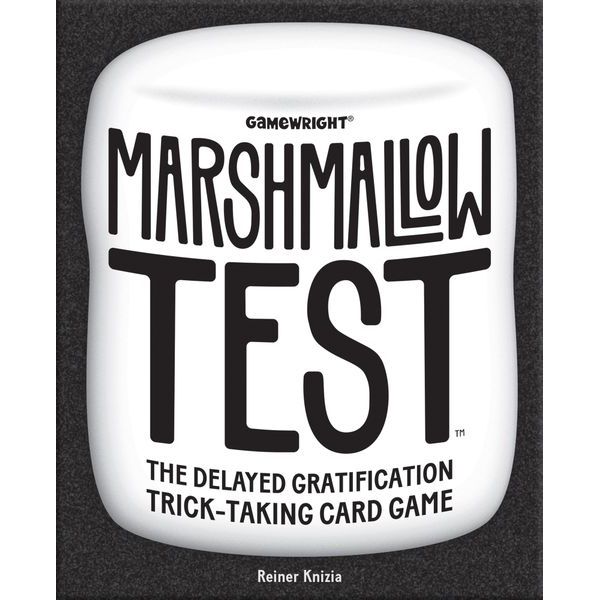How Long Will You Hold Out in Marshmallow Test?

Will you win all the tricks right away and only collect a marshmallow or two? Or try to stay in a little longer to get more? Be sure to get out while you still can, however, as the last player left standing doesn’t get any marshmallows at all!
Published by Gamewright and designed by Reiner Knizia (Lost Cities, Blue Lagoon, The Quest for El Dorado), Marshmallow Test is a trick-taking card game with a unique scoring twist.
Gameplay
The deck is made of sixty cards. Cards come in five different colors and are numbered one through five. At the start of each round, each player is dealt a hand of twelve cards.
Marshmallow Test is a trick-taking game, so many of the rules will be familiar. The dealer starts each round by playing a card to start a trick. Other players must always follow the card’s color if they can, with the highest card in that color taking the trick. The player who wins the trick places it in front of himself, before playing a new card to start a new trick. You always keep the tricks you win during the round separate from each other so that it is clear how many you have won.
Depending on the number of players, there are a different number of tricks you are allowed to win before you go out for the rest of the round. For example, in a four-player game, once you have won your third trick, you go out. When you go out, you then win one marshmallow token for each trick each other player has already won this round. The round ends once there is only one player left in the round — this player receives no marshmallows. Instead, he or she becomes the dealer for the next round and, after seeing his new hand of cards, gets to choose which color will be the trump color for this new round.
If you do not have the proper color of card to play during a trick, you may instead play a trump color. Once someone has played a trump card into a trick, any other player may also play a trump card in that trick, even if they could match the original card’s color. The highest trump card always wins a trick.
Once a player has won twenty or more marshmallows, they immediately win the game. You do not finish out the round.

Review
Almost everyone knows the concept of tricks, trump cards, and following suit, which makes Marshmallow Test a very simple game to teach. However, the core challenge at the heart of the game is fresh and original and makes for an interesting experience.
The ideal is to go out second-to-last, as this will ensure you get the most points. You can sometimes even play dangerously and allow the other player still in the round another trick or two in an effort to increase your score further. But it’s better to go out earlier than not at all. Additionally, since a player keeps his remaining cards secret after going out, and not all cards are necessarily dealt out depending on player count, you can’t always be sure what cards an opponent might have in hand — so there can be an almost push-your-luck nature to trying to stay in until next-to-last. However, this mechanism doesn’t work as well with two players, in which only one player will ever get to go out each round.
This balance of when to go out and when to stay in longer is key to success and has you approach each trick and your cards differently than in other trick-taking games. Also, the fact that the game ends immediately once someone reaches twenty marshmallows, means that every point can be quite important by the end of the game.
There is also something a bit lackluster about the artwork on the cards themselves, but they are easy to read and are made of a nice quality, and the marshmallow tokens are quite fun and squishy.
While there are a lot of trick-taking games out there, Marshmallow Test does manage to bring something new and enjoyable to the genre. It’s a nice combination of trick-taking and push-your-luck, is very accessible, and plays fast.
Pros: Very accessible but still with a twist to classic trick-taking, a fun push-your-luck element, very easy to teach
Cons: Aesthetics are a little lackluster, not at its best with two players
Disclosure: we received a complimentary review copy of this game.







